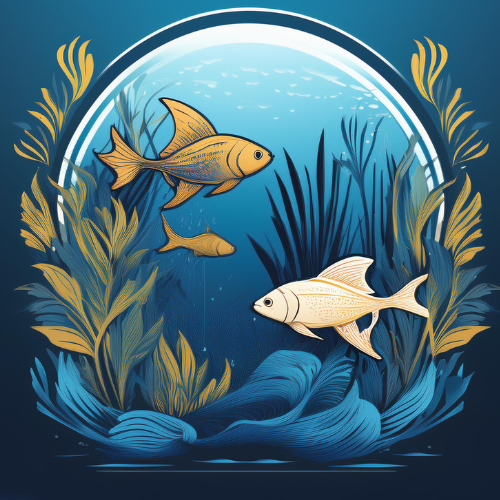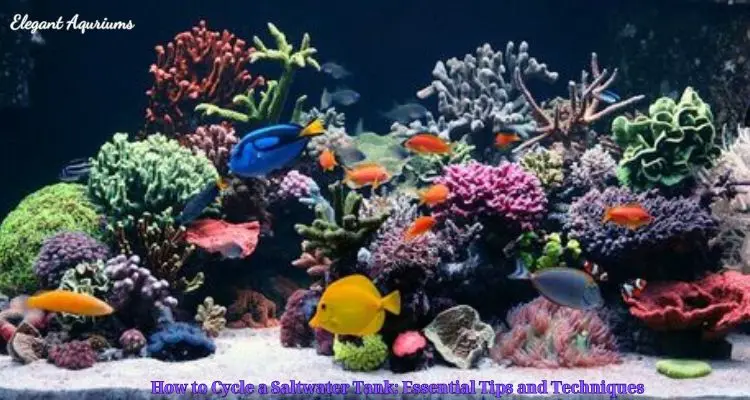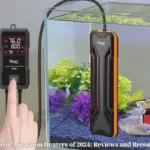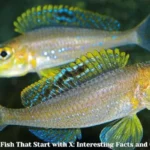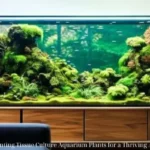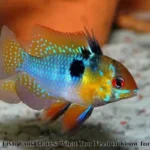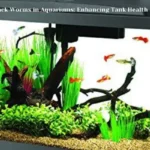Fish care
How to Cycle a Saltwater Tank: Essential Tips and Techniques
Setting up a saltwater tank is an exciting endeavor that requires careful planning and attention to detail. One of the most crucial steps in how to cycle a saltwater tank is ensuring that the water conditions are suitable for fish, invertebrates, and corals by establishing beneficial bacteria that help maintain water quality. This process is essential for creating a healthy marine environment. In this guide, Elegant Aquriums will explore the essential tips and techniques for cycling a saltwater tank, ensuring a stable and thriving aquatic ecosystem.
Understanding the Nitrogen Cycle
Before diving into the steps of cycling a saltwater tank, it’s important to understand the nitrogen cycle, a fundamental biological process that occurs in all aquariums. The nitrogen cycle involves the conversion of harmful ammonia into less toxic substances through the action of beneficial bacteria. This cycle consists of three main stages:
1. Ammonia Stage
Ammonia is produced from fish waste, uneaten food, and decaying organic matter. In a newly set-up tank, ammonia levels rise quickly and can be toxic to marine life if not managed properly. Ammonia is highly soluble in water and can cause damage to the gills and tissues of aquatic organisms. Monitoring ammonia levels during the initial setup is critical to ensure the health of your tank’s inhabitants.
2. Nitrite Stage
Nitrosomonas bacteria convert ammonia into nitrite, another toxic compound. Although nitrite is less harmful than ammonia, high concentrations can still pose a threat to aquatic inhabitants. Nitrite affects the blood’s ability to carry oxygen, leading to respiratory distress in fish. The presence of nitrite indicates that the tank is transitioning through the nitrogen cycle, but care must be taken to prevent prolonged exposure.
3. Nitrate Stage
Nitrobacter bacteria convert nitrite into nitrate, which is relatively harmless in low concentrations. Nitrate is the final product of the nitrogen cycle and is much less toxic than ammonia or nitrite. However, high nitrate levels can still lead to poor water quality and promote unwanted algae growth. Regular water changes and the use of live plants or algae can help keep nitrate levels in check.
How to Cycle a Saltwater Tank: Step-by-Step Process

Cycling a saltwater tank involves establishing these beneficial bacteria to ensure a stable nitrogen cycle. Here are the essential steps to achieve this:
1. Setting Up the Tank
Begin by assembling your saltwater tank with the necessary equipment, including a protein skimmer, heater, powerhead, and lighting system. Fill the tank with dechlorinated water and add the appropriate amount of marine salt to achieve the desired salinity level, typically between 1.020 and 1.026 specific gravity. Ensure that the water temperature is within the recommended range for your tank’s inhabitants, usually between 76°F and 82°F (24°C to 28°C).
2. Adding Substrate and Live Rock
The substrate and live rock provide surfaces for beneficial bacteria to colonize. Use a suitable substrate, such as aragonite sand, and arrange live rock to create a natural aquascape. Live rock not only offers biological filtration but also enhances the aesthetics of the tank. It’s important to choose high-quality live rock, as it can introduce diverse beneficial microorganisms and contribute to the overall health of the aquarium.
3. Introducing a Source of Ammonia
To kickstart the nitrogen cycle, introduce a source of ammonia. This can be done in several ways:
- Fishless Cycling: Add pure ammonia or ammonium chloride to the tank, following the manufacturer’s instructions to achieve an ammonia concentration of 2-4 ppm. Fishless cycling is a humane method that avoids subjecting live fish to toxic ammonia levels.
- Using Fish Food: Place a small amount of fish food in the tank to decompose and release ammonia. This method is slower but can be effective for those who prefer a natural approach.
- Using a Shrimp: Place a raw shrimp in the tank, allowing it to decay and produce ammonia. The shrimp method is a traditional technique that mimics the natural breakdown of organic matter.
4. Monitoring Water Parameters
Throughout the cycling process, regularly test the water for ammonia, nitrite, and nitrate levels using reliable test kits. Record the results to track the progress of the cycle.
- Ammonia Levels: Initially, ammonia levels will rise as the bacteria begin to colonize. Monitor closely and avoid adding any fish until levels decrease to 0 ppm. Ammonia spikes are expected during the early stages of cycling.
- Nitrite Levels: As ammonia levels drop, nitrite levels will rise. Continue testing until nitrite levels also reach 0 ppm. Nitrite can linger longer than ammonia, so patience is key.
- Nitrate Levels: Once nitrite is converted to nitrate, you may notice a gradual increase in nitrate levels. Perform partial water changes to keep nitrate levels below 20 ppm. Elevated nitrates can lead to algae blooms and stress in sensitive species.
5. Patience is Key
Cycling a saltwater tank can take anywhere from 2 to 8 weeks, depending on various factors such as tank size, temperature, and the initial bacterial population. Patience is essential during this time, as rushing the process can lead to poor water quality and stress for marine life. Resist the urge to add fish or corals prematurely, as the tank’s ecosystem is still stabilizing.
6. Introducing Clean-Up Crew
Once ammonia and nitrite levels have reached zero, and nitrate levels are manageable, consider introducing a clean-up crew. Snails, hermit crabs, and other small invertebrates can help control algae and detritus, contributing to a healthier environment. A well-chosen clean-up crew can also aid in keeping the substrate clean and free from excess waste.
7. Gradually Adding Fish and Corals
With the nitrogen cycle established, you can begin adding fish and corals to the tank. Introduce new inhabitants gradually to prevent sudden spikes in ammonia and to allow the beneficial bacteria to adjust to the increased bioload. Start with hardy species that are more tolerant of slight fluctuations in water parameters.
8. Regular Maintenance and Monitoring
Maintaining a stable and healthy saltwater tank requires ongoing attention and care:
- Water Changes: Perform regular water changes of 10-20% every 1-2 weeks to maintain water quality and replenish trace elements. Consistent water changes help control nitrate levels and prevent the accumulation of harmful substances.
- Testing Water Parameters: Continue monitoring ammonia, nitrite, nitrate, pH, salinity, and other essential parameters to ensure optimal conditions. Regular testing allows for early detection of potential issues.
- Cleaning Equipment: Clean the protein skimmer, powerheads, and other equipment regularly to prevent buildup and maintain efficiency. Proper maintenance of equipment ensures optimal performance and water quality.
- Observing Tank Inhabitants: Pay close attention to the behavior and health of fish, invertebrates, and corals. Any signs of stress or illness may indicate water quality issues. Observe feeding patterns, color changes, and interactions between species.
Tips for a Successful Cycling Process
1. Use Live Rock
Incorporating live rock into your saltwater tank can accelerate the cycling process. Live rock is already colonized with beneficial bacteria, helping to establish the nitrogen cycle more quickly. Additionally, it provides hiding places and surfaces for corals and other marine life. When selecting live rock, consider its origin, porosity, and visual appeal to match your tank’s aesthetic.
2. Avoid Overfeeding
Overfeeding can lead to excess waste and increased ammonia levels. Feed sparingly during the cycling process and remove any uneaten food promptly to maintain water quality. Establishing a feeding routine helps prevent overfeeding and reduces the risk of nutrient spikes.
3. Consider a Bacterial Supplement
Bacterial supplements can boost the initial bacterial population, helping to speed up the cycling process. Choose a reputable product and follow the instructions carefully. These supplements can introduce beneficial strains of bacteria that promote a healthy nitrogen cycle.
4. Maintain Consistent Temperature and Salinity
Stable temperature and salinity levels are crucial for the health of marine life and the efficiency of the nitrogen cycle. Use a reliable heater and refractometer to maintain consistent conditions. Fluctuations in temperature and salinity can stress fish and corals, making them more susceptible to disease.
5. Be Patient and Monitor Progress
Cycling a saltwater tank takes time and careful observation. Avoid the temptation to add fish and corals prematurely, as this can lead to water quality issues and stress for the inhabitants. Patience is key to achieving a stable and thriving marine ecosystem.
Troubleshooting Common Cycling Issues
1. Persistent Ammonia or Nitrite Levels
If ammonia or nitrite levels remain high after several weeks, consider the following:
- Check for Excess Waste: Remove any decaying organic matter, such as uneaten food or dead organisms, that may be contributing to elevated ammonia levels. Regularly vacuum the substrate to remove detritus and prevent buildup.
- Increase Aeration: Ensure adequate water circulation and aeration to promote bacterial growth and oxygen exchange. Proper aeration enhances the efficiency of the nitrogen cycle.
- Evaluate the Bacterial Population: If using live rock, check for signs of die-off, which can impact bacterial colonization. Consider adding a bacterial supplement to boost the population. Monitor the condition of live rock and address any visible issues.
2. High Nitrate Levels
Elevated nitrate levels can result from overstocking or inadequate filtration. To address high nitrate levels:
- Perform Water Changes: Increase the frequency and volume of water changes to reduce nitrate concentration. Regular water changes are a reliable method for controlling nitrates.
- Improve Filtration: Consider upgrading or adding additional filtration media, such as bio-media or a refugium with macro.
- algae: Adding bio-media or creating a refugium with macroalgae can help reduce nitrates by providing additional surfaces for beneficial bacteria and natural nutrient export.
- Reduce Feeding: Limit feeding to prevent excess waste and nutrient buildup. Feed only the amount your fish can consume within a few minutes, and remove uneaten food promptly.
- Introduce Live Plants: In a saltwater setup, adding macroalgae like Chaetomorpha or Caulerpa can help absorb nitrates. These plants utilize nitrates as a nutrient source, reducing their concentration in the water.
3. Cloudy Water
Cloudy water during cycling is often caused by bacterial blooms, which are usually harmless and temporary. However, if the cloudiness persists:
- Check Filtration: Ensure that your mechanical filtration is working properly and consider adding a fine filter pad to trap suspended particles. Regularly clean or replace filter media as needed.
- Avoid Overfeeding: Reduce feeding and ensure that all food is consumed quickly. Overfeeding can lead to excess organic matter that promotes bacterial blooms.
- Increase Aeration and Circulation: Enhancing water movement can help clear up cloudy water by promoting the efficient breakdown of organic matter. Proper circulation also ensures that all areas of the tank receive adequate oxygen.
Conclusion
Cycling a saltwater tank is a critical step in establishing a healthy and thriving marine environment. By understanding the nitrogen cycle and following essential tips and techniques, you can ensure a successful cycling process and create a stable habitat for your aquatic inhabitants.
Remember, patience and diligence are key during this process. Monitor water parameters closely, perform regular maintenance, and introduce fish and corals gradually. With the right approach, your saltwater tank will flourish, providing a beautiful and captivating display of marine life.
